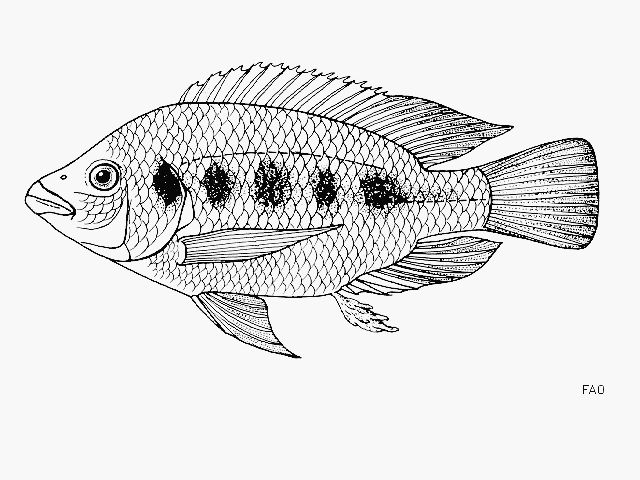|
Dorsal spines (total): 15-16; Dorsal soft rays (total): 12-13; Anal spines: 3-3; Anal soft rays: 10-11; Vertebrae: 29. Diagnosis: A large bodied Oreochromis, characterised by elongated jaws, projecting forwards to form a long snout, with the tooth-bands meeting in the horizontal plane; broad bands of tricuspid teeth, with long, slender shafts and curved crowns, arranged in broad bands; maxilla with a flange resting on the premaxilla at the curve between its two arms; and dorsal region and flanks dark green/olive, ventral region lighter (Ref. 2, 118638). A tasseled species (Ref. 2). Fins of ripening males dark with orange lappets on the dorsal, female fins plain grey/olive (Ref. 118638). Females and non-breeding males have 3 large blotches on the flanks (Ref. 118638). Fully ripe males are purplish blue with dark spots on the flank scales, a blue-green head, bright blue lips and have blue-white stripes and spots on the dorsal, anal and tail fins; the dorsal and tailfins have broad orange margins, and there is a long, branched orange/red genital tassel (Ref. 118638).
Description: mouth and lips large; maxillary not reaching anterior border of eye (Ref. 53528). Premaxillary pedicels (ascending processes) reinforced posteriorly and, asymmetrically, on their lateral faces; jaw teeth movable (Ref. 2). Broad bands of teeth visible when the mouth is closed (Ref. 54836). Blade of lower pharyngeal jaw nearly twice as long as the median length of the toothed area; pharyngeal teeth slender, crowded and movable (Ref. 2). Scales on cheek in 2 or 3 rows (Ref. 2, 53528, 55078). 4-5 scales between bases of pectoral and pelvic fins (Ref. 2). Upper lateral line with 20-21 scales, lower with 11-12 scales; 14 scales between upper lateral line and medioventral line; abdominal and especially thoracic scales relatively small (Ref. 53528, 55078). Lateral line extending for 2 scales on caudal fin base (Ref. 55078). Dorsal fin almost reaching middle of caudal fin in adults and the caudal fin base in juveniles; anal fin reaching as far as dorsal fin; pectoral fin always reaching beyond vent (Ref. 55074). Pelvic fins extending to vent or genital papilla (Ref. 2), but never as far as the pectoral fins (Ref. 55074). Caudal fin finely scaled, except at the border (Ref. 53528, 55078). Genital papilla enlarged, bifid and dendritic in mature fishes of both sexes (Ref. 2), in breeding males up to 10-15cm, with semitransparent filaments and blobs of bright orange tissue (Ref. 2, 55077), but in mature females only about 5mm long (Ref. 2).
Colouration: Non-breeding fishes: ground color olive, darker on the upper part of the body by reason of black center to each scale (Ref. 2, 55077). 3-4 large, dark mid-lateral blotches, in preserved fishes often united by a vague band; black spots associated with the openings of the lateralis system of the temporal region, the infraorbital canal and the vertical limb of the preopercular; series of spots or stripes on the dorsal fin; caudal covered with dark spots, often mixed with pale spots (Ref. 2). Spots on caudal fin may become elongated (Ref. 54836). Pectoral fins transparent; pelvic fins blackish (Ref. 55074). Breeding males: in life brilliantly colored, giving a general impression of bright blue and orange (Ref. 2, 55077), the orange coloring the margins of dorsal (Ref. 2, 4967, 54836, 55077) and caudal fins (Ref. 2, 55077), and the long genital papilla (Ref. 2, 54836, 55077). General body color blue-grey with purplish sheen; head blue-green with peacock-blue lips; the broad bands of teeth appearing pink; pectoral fins grey; pelvic fins with blue markings and black leading edge; caudal and soft dorsal with light blue spots and streaks (Ref. 2, 55077). Mature females: less brightly colored, without the orange of the caudal margin (Ref. 2, 55077), but with orange dorsal fin margin (Ref. 2, 4967, 54836, 55077) and below it oblique rows of whitish spots (Ref. 2, 55077). General body color greenish-brown (Ref. 55077). Lips peacock-blue as in male; opercular spot violet (Ref. 2, 55077). |

